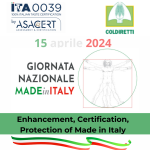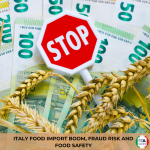Between homemade pasta, rustici and traditional sweets, tables in Italy at Easter are richer than usual. From Lombardy to Liguria, from Campania to Sicily and around the peninsula, traditions for Easter are a serious business, and when it comes to food, the issue is paramount.
Italians at Easter turn out to be a bit parochial: 32% choose the dish of their region, with percentages reaching 53% in Campania (with Pastiera and Casatiello) and 45% in Veneto (the recipe is Fugassa, a typical sweet leavened bread).
At national level, the great classics are on the podium: Casatiello, Pastiera (at 26.4%) and Colomba (20.6%). They are followed by the Ligurian torta Pasqualina (18.9%) and Fiadoni, cheese-filled crescent-shaped bundles to be enjoyed in a sweet or savoury version, according to family tradition, between Molise and Abruzzo (16.4%); the Umbrian Pizza di Pasqua (15.6%), the Scarcella pugliese (typical biscuit with egg and frosting on top, 15.2%) and the Bensone (14.9%), a sweet with a millenary tradition from Modena. Recipes also include the Piedmontese Rognosa omelette (14.4%), the Tuscan Pasimata (an alternative to the classic colomba, with sultanas and aniseed seeds, known by some as schiaccia, 13.9%) and the Veneto Fugassa, a typical sweet leavened bread (12.1%). Eggs are an ever-present food on the Easter table for more than one Italian in three (34.5%), surpassed only by the chocolate egg and colomba (indispensable for more than 60% of Italians) and preferred to lamb (31.9%), salami (30.5%) and savoury cheese pie (22%).
We have chosen to tell you, for this Holy Easter, two typical and representative recipes of this period full of meanings, which enclose an intense sacredness and have their roots – as always happens in the Italian culinary tradition – in ancient and simple rituals, which know how to combine religiosity and worldliness.
THE NEAPOLITAN ‘PASTIERA’
It is one of the most famous and appreciated Neapolitan Easter sweets in all of Italy. The Neapolitan pastiera is the queen of the table during Easter, a dessert that has its origins in legend. The history of the Neapolitan pastiera, linked to the cult of the Roman goddess Ceres, officially began in 1693, when its multi-step recipe was put down in black and white in the book Lo scalo alla moderna by Antonio Latini, and then perfected over the following centuries. Today, the ingredients of the Neapolitan pastiera are few and simple: shortcrust pastry, wheat cooked in milk, ricotta cheese and eggs, and millefiori flavouring, but it is the long processing that makes it a gastronomic masterpiece that, fortunately, can also be found on Italian tables at other times of the year.
THE LIGURIAN ‘TORTA PASQUALINA’:
On the typical Easter menu in Genoa, and throughout Liguria, there is a savoury delicacy that is never missing: torta pasqualina, a feast of puff pastry filled with spinach, ricotta cheese, cheese and whole eggs.The original recipe for torta pasqualina, perfected in the 1800s, calls for the use of 27 very thin sheets of pastry, but according to tradition there were as many as 33 layers to be layered on top of each other, the number of years Christ was alive at the time of his death and resurrection, which is commemorated precisely at Easter. The ingredients of torta pasqualina vary, however, from area to area. Some prepare it with cream of chard instead of spinach, some use wild herbs and some artichokes, but ricotta and eggs are constants that you will find in all variations.
Whatever your favourite Easter dish is, wherever you are in the world, ITA0039 wishes you an authentic and genuine Easter, like the foods of the Italian tradition, to rediscover the ancient flavours of our country, wherever you are in the world. Happy Easter.






